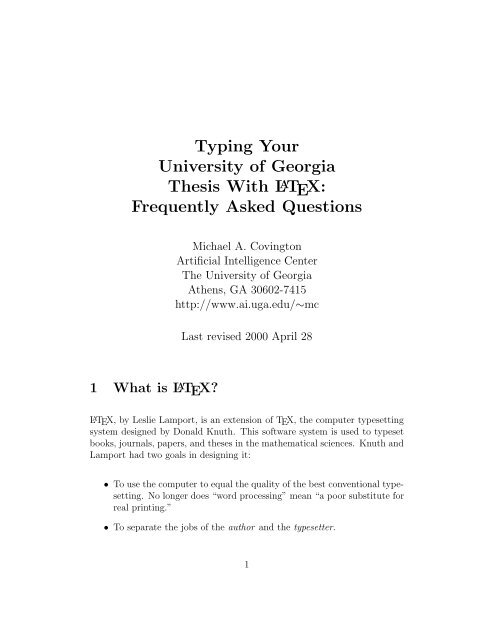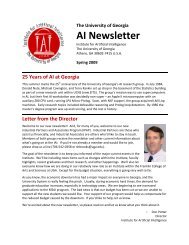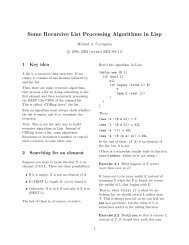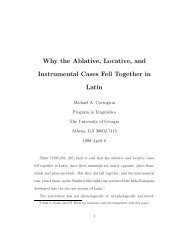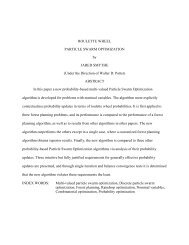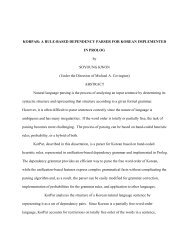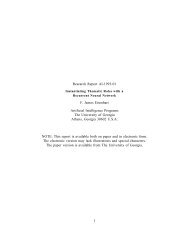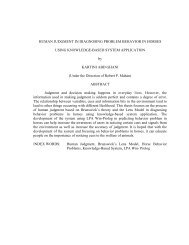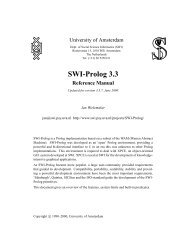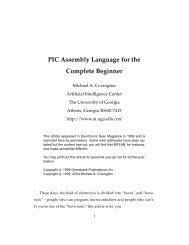Typing Your University of Georgia Thesis With LATEX - Artificial ...
Typing Your University of Georgia Thesis With LATEX - Artificial ...
Typing Your University of Georgia Thesis With LATEX - Artificial ...
You also want an ePaper? Increase the reach of your titles
YUMPU automatically turns print PDFs into web optimized ePapers that Google loves.
<strong>Typing</strong> <strong>Your</strong><br />
<strong>University</strong> <strong>of</strong> <strong>Georgia</strong><br />
<strong>Thesis</strong> <strong>With</strong> L A TEX:<br />
Frequently Asked Questions<br />
Michael A. Covington<br />
<strong>Artificial</strong> Intelligence Center<br />
The <strong>University</strong> <strong>of</strong> <strong>Georgia</strong><br />
Athens, GA 30602-7415<br />
http://www.ai.uga.edu/∼mc<br />
Last revised 2000 April 28<br />
1 What is L A TEX?<br />
L A TEX, by Leslie Lamport, is an extension <strong>of</strong> TEX, the computer typesetting<br />
system designed by Donald Knuth. This s<strong>of</strong>tware system is used to typeset<br />
books, journals, papers, and theses in the mathematical sciences. Knuth and<br />
Lamport had two goals in designing it:<br />
• To use the computer to equal the quality <strong>of</strong> the best conventional typesetting.<br />
No longer does “word processing” mean “a poor substitute for<br />
real printing.”<br />
• To separate the jobs <strong>of</strong> the author and the typesetter.<br />
1
Other word processors turn the screen into a blank piece <strong>of</strong> paper and let<br />
you type on it. L A TEX isnotyourtypewriter, it’s your typist. For example,<br />
to mark the beginning <strong>of</strong> a chapter, you type something like this:<br />
\chapter{Literature Review}<br />
and L A TEX automatically determines what a chapter heading should look<br />
like. It does this by consulting a style sheet. You do not have to worry about<br />
whether you’ve hit Enter the same number <strong>of</strong> times at the beginning <strong>of</strong> each<br />
chapter, or whether all the chapter headings are centered and the margins<br />
are correct. That’s the (automated) typist’s job.<br />
2 How is “L A TEX” pronounced?<br />
The X in TEX is actually a Greek chi, with the sound <strong>of</strong> ch in Scottish loch or<br />
German ach. Thus,TEX is pronounced “tekh.” It is short for Greek tekhnē<br />
“art, craft.”<br />
L A TEX is pronounced ‘‘lah-tekh” in the Northeast, ‘‘lay-tekh” in England and<br />
the South, and several different ways in the West.<br />
3 What’s it like to run L A TEX?<br />
L A TEX isnot a single integrated piece <strong>of</strong> s<strong>of</strong>tware. It has several parts. The<br />
normal process for typing and printing a paper is as follows. On finding an<br />
error or discovering that a change is needed, you can go back to any earlier<br />
step at any time.<br />
1. Use a text editor (Windows Notepad or whatever text editor you like)<br />
to type your document on a file whose name ends in ṫex.<br />
2. Go to a command prompt and run latex to create a .dvi file.<br />
2
3. Optionally, preview the .dvi file on-screen. Some <strong>of</strong> us skip this step.<br />
4. Run dvips to convert the .dvi file to PostScript.<br />
5. Use GhostView to view the PostScript file and print it (even if you do<br />
not have a PostScript printer).<br />
4 Who benefits the most from using L A TEX?<br />
Those who need to typeset mathematical formulas or computer programs;<br />
those whose theses are likely to be published by a book publisher; and those<br />
who plan to submit their theses electronically.<br />
5 Who should not use L A TEX?<br />
If you consider yourself a “computer dummy” and can use only the simplest<br />
s<strong>of</strong>tware, or if you do not have the time or patience to learn a new set <strong>of</strong><br />
technical skills, you won’t like L A TEX. On the other hand, you probably will<br />
not type your thesis correctly with a conventional word processor either.<br />
(Let’s face it, typing a thesis correctly is a technical challenge, no matter<br />
what s<strong>of</strong>tware you do it with!) You should hire a typist.<br />
6 What are MikTEX, emTEX, teTEX, etc.?<br />
These are implementations <strong>of</strong> L A TEX for particular computers, incorporating<br />
Knuth and Lamport’s original computer programs plus various tools to make<br />
them easier to use or more versatile. All <strong>of</strong> them are 100% compatible with<br />
the original L A TEX.<br />
3
7 Is there L A TEX for Macintosh, Linux, Amiga,<br />
Sun, BeBox...?<br />
Yes. L A TEX has been ported to a huge variety <strong>of</strong> computers and produces<br />
identical output on all <strong>of</strong> them, using identical file formats. If you have<br />
Linux, you almost certainly already have L A TEX.<br />
8 What is L A TEX2ε?<br />
The version <strong>of</strong> L A TEX that has been in use for the last several years. It was<br />
preceded by L A TEX 2.09. Those are the only two version <strong>of</strong> L A TEX thathave<br />
been distributed widely. There will eventually be a L A TEX 3, but not very<br />
soon.<br />
9 Where do I get L A TEX?<br />
You can download it free <strong>of</strong> charge from various sites; follow the links on<br />
Michael Covington’s web page (http://www.ai.uga.edu/∼mc). You can sometimes<br />
borrow a CD-ROM containing MikTEX and GhostView from the <strong>Artificial</strong><br />
Intelligence Center.<br />
10 Where is the documentation for L A TEX?<br />
In the book LaTeX: A Document Preparation System, by Leslie Lamport,<br />
2nd edition, published by Addison-Wesley. You must buy this book.<br />
Other books about L A TEX are useful but are not the <strong>of</strong>ficial guide.<br />
4
11 Where can I get help with L A TEX?<br />
First, read Lamport’s book. You cannot get along without it.<br />
Second, you can ask questions on the newsgroups comp.text.tex (international)<br />
and uga.tex-latex (local, only accessible on campus).<br />
Third, if you have problems that are specific to uga.sty, and particularly<br />
if uga.sty does not appear to be meeting UGa thesis format requirements,<br />
please contact me (Michael Covington, mc@uga.edu).<br />
12 What is uga.sty?<br />
A style sheet for L A TEX that makes it follow the format for <strong>University</strong> <strong>of</strong><br />
<strong>Georgia</strong> theses and dissertations.<br />
13 Where do I get uga.sty and how do I install<br />
it?<br />
Download it from ftp://ftp.ai.uga.edu/pub/tex/uga-thesis. Be sure to get<br />
the latest version.<br />
Install it by putting it in the same directory as your thesis, or in directory<br />
texmf/tex/latex <strong>of</strong> your TEX system.<br />
Be sure to get the file ugasampl.tex along with it.<br />
14 Where is the documentation for uga.sty?<br />
You’re looking at part <strong>of</strong> it. The rest is in the files uga.sty and ugasampl.tex.<br />
You can and must read these files with your text editor.<br />
5
15 Do I have to get uga.sty before typing my<br />
thesis?<br />
No. You can type your thesis using the L A TEX report documentclass (described<br />
in Lamport’s Book); this will enable you to produce neat, singlespaced<br />
copies <strong>of</strong> the work in progress. When it’s finished, get uga.sty and<br />
make the small additions to your thesis that are described there.<br />
16 What are the required parts <strong>of</strong> a thesis<br />
typed with uga.sty?<br />
They are described in uga.sty itself, which you can read with your text<br />
editor. Alternatively, you can use ugasampl.tex as sample to imitate.<br />
17 Why is my table <strong>of</strong> contents blank or incorrect?<br />
You must run L A TEX twice in order to get a correct table <strong>of</strong> contents. The<br />
first time, it keeps records <strong>of</strong> where things are; the second time, it actually<br />
generates the table <strong>of</strong> contents. If the table <strong>of</strong> contents is long, you may need<br />
to run L A TEX three times to ensure that adequate space is left for it.<br />
18 How do I type a percent sign?<br />
See Lamport’s book. A quick answer: Type “\%”.<br />
6
19 How do I type a tilde (∼)?<br />
This character <strong>of</strong>ten occurs in web addresses. You will quickly discover that in<br />
L A TEX, when you type “~” you get a blank. (Specifically, you get a “required<br />
space,” a space that cannot be broken across a line break.)<br />
To get “∼” type“$\sim$”.<br />
20 What are italics used for?<br />
All <strong>of</strong> the things that would be underlined in a handwritten document, including<br />
titles <strong>of</strong> books, foreign words, and the like.<br />
In linguistics, it is normal to put foreign words in italics and their definitions<br />
in single quotes. For example, Agatha Christie’s famous detective is named<br />
after the French word poireau ‘leek’.<br />
21 What is underlining used for?<br />
Almost nothing. Roman type is not normally underlined; use italics instead.<br />
22 What is typewriter type used for?<br />
Computer program languages, whether displayed or quoted in text.<br />
example, here is part <strong>of</strong> a program written in C:<br />
For<br />
for(i=100,i>0,i--)<br />
{<br />
printf("%d bottles <strong>of</strong> beer on the wall...\n");<br />
}<br />
7
It demonstrates how to use the for statement to count down from 100 to 1.<br />
23 What is the verbatim environment used<br />
for?<br />
Computer programs, as just demonstrated.<br />
24 What is sans-serif type used for?<br />
Almost nothing except labels within illustrations.<br />
25 How do I type the bibliography?<br />
See Lamport’s book. L A TEX allows you to refer to bibliography items in your<br />
text with markers such as \cite{Chomsky} then have L A TEX automatically<br />
turn these into bracketed numbers in the bibliography.<br />
<strong>With</strong> uga.sty, simply use the thebibliography environment exactly as<br />
Lamport describes it. This will produce a bibliography in the form <strong>of</strong> an<br />
unnumbered chapter at the end <strong>of</strong> your thesis.<br />
26 What if each chapter has its own bibliography?<br />
If you have bibliographies at the ends <strong>of</strong> the individual chapters, use the<br />
environment chapterbibliography instead <strong>of</strong> thebibliography. It works<br />
exactly the same way except that the bibliography becomes a normally num-<br />
8
ered section, not an unnumbered chapter. There is an example <strong>of</strong> this in<br />
ugasampl.tex.<br />
The chapterbibliography environment is provided by uga.sty.<br />
27 What if I don’t like bracketed numbers?<br />
Here is an example <strong>of</strong> a trick to get L A TEX to print a bibliography without<br />
bracketed numbers. Basically, you are telling L A TEX to put the author’s name<br />
in place <strong>of</strong> the bracketed number. Note that this involves using \item rather<br />
than \bibitem.<br />
\begin{thebibliography}{}<br />
\item[Covington, Michael A.]<br />
\emph{Natural Language Processing for Prolog Programmers.}<br />
Englewood Cliffs, N.J.: Prentice Hall, 1994.<br />
\item[O’Keefe, Richard A.]<br />
\emph{The Craft <strong>of</strong> Prolog.}<br />
Cambridge, Mass.: MIT Press, 1991.<br />
\end{thebibliography}<br />
When doing this, don’t use the \cite command; instead, handle your references<br />
manually.<br />
You can do exactly thesamethingwithchapterbibliography.<br />
9
28 Why is there too much space after some<br />
<strong>of</strong> the periods?<br />
L A TEX assumes that every period marks the end <strong>of</strong> a sentence, so it leaves<br />
extra space after it. You should use a required space (~) after every period<br />
that does not mark the end <strong>of</strong> a sentence. Type “T.~S.~Eliot” toprint<br />
“T. S. Eliot” or the like.<br />
Alternatively, right after \begin{document} you can issue the command<br />
\frenchspacing<br />
in order to turn <strong>of</strong>f the extra space after periods. “French” spacing is perfectly<br />
acceptable in an American thesis.<br />
29 Why do some words hang out past the<br />
right margin?<br />
When L A TEX cannot break a line satisfactorily, it leaves a word sticking out<br />
into the margin and gives you an “Overfull hbox” error message. It is up to<br />
you to rearrange the text so that it fits.<br />
30 What is an overfull hbox?<br />
See previous question.<br />
10
31 How do I turn <strong>of</strong>f justification?<br />
Justification means printing with a straight right margins. It is not required<br />
for <strong>University</strong> <strong>of</strong> <strong>Georgia</strong> theses, and if your text contains many formulas,<br />
web addresses, or other unbreakable items, you may get considerably neater<br />
results by turning it <strong>of</strong>f. To do this, issue the command<br />
\raggedright<br />
immediately after \begin{document}.<br />
You may need to turn <strong>of</strong>f justification only within a bibliography. In that<br />
case, put the \raggedright command after \begin{thebibliography} or<br />
\begin{chapterbibliography} as the case may be. It will then affect only<br />
the bibliography.<br />
32 How do I put a picture into my thesis?<br />
Here’s the process...<br />
1. Learn the difference between a vector (“draw”) program and a bitmap<br />
(“paint”) program. Vector programs, such as Corel Draw and Micrografx<br />
Windows Draw, tell the computer to draw lines at particular<br />
positions; they are the right tool for generating diagrams <strong>of</strong> all types.<br />
Bitmap programs are only for working with digitized photographs and<br />
the like; their output has an unpleasant stairstep appearance when<br />
enlarged or resized.<br />
2. Produce pr<strong>of</strong>essional-quality artwork. (You may want to hire a pr<strong>of</strong>essional<br />
illustrator.) Artwork in your thesis should look as good as the<br />
artwork in published books.<br />
3. Save your artwork as an encapsulated PostScript (EPS) file with no<br />
TIFF header. (The drawing s<strong>of</strong>tware may ask you whether you want a<br />
TIFF header; say no.)<br />
11
4. Use the graphics package (described in Lamport’s book) or the epsf<br />
package to incorporate your art into your L A TEX document. One way<br />
to do this is as follows:<br />
(a) Add the command \usepackage{epsf} right after \documentclass.<br />
(b) Use the command \centerline{\epsffile{xxxxxxx.eps}} (with<br />
the appropriate filename substituted) to put the picture in your<br />
document. Normally this will be within a figure environment as<br />
described in Lamport’s book.<br />
33 How do I put a Windows screen shot into<br />
my thesis?<br />
When writing about s<strong>of</strong>tware, you many need a picture <strong>of</strong> the computer<br />
screen with a program running. Under Windows 95 and up, you can “take<br />
a picture” <strong>of</strong> the screen, by pressing Print Screen (or Alt-Print Screen if<br />
you only need the current window). This puts a copy <strong>of</strong> the screen into<br />
the Windows clipboard. Then open up your favorite paint program (bitmap<br />
program) and choose Paste. Edit the picture to your satisfaction, save it,<br />
and export it as encapsulated PostScript. For the rest <strong>of</strong> the process, see the<br />
previous question.<br />
12


